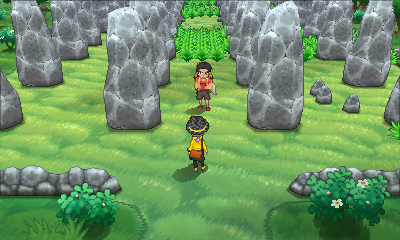Aloha, Alola! PokéCommunity Daily’s Pokémon Sun and Moon Review
For both new and experienced players, Pokémon Sun and Moon introduce many significant, most welcome changes to the gameplay and the formula. Check out Daily’s extensive review on what’s new.
Graphics: a whole new way to see

Pokémon games have, for the most part, adhered to a very similar design, both in and out of battles. The game world which the player navigates has been, up to this point, very similar in style across Pokémon games. The areas, with some exceptions, always adhered to a square grid for each part of its environment. The players would be represented as a miniature version of their actual art, and the environments around them would be scaled to match.
The player would be able to browse the environment by moving between these squares. Up until the sixth-generation Pokémon games, the player could only move completely into the next square, and only within four directions — up, down, left, or right.
The fifth- and sixth-generation Pokémon games shook this up to varying extents. Pokémon Black and White, the first set of fifth-generation Pokémon games, introduced Castelia City, which reused the familiar square movement grid of sorts, but stuck the player to a curved track to show movement in more natural directions. The sixth generation games, starting with Pokémon X and Y, introduced diagonal movement in all areas of the game, made the grid optional in some areas thus allowing for stepping in-between squares, and removed the grid entirely in areas such as Lumiose City.
This resulted in the sixth-generation games having a mishmash of control schemes and area designs. It also introduced some control issues, particularly when navigating tight corners or mazes. These issues would be exacerbated by using the 3DS Circle Pad to navigate the environment, forcing the player to use the D-Pad to move around, which would return the player character to using grid-based movement. This made the games’ 3D design contrast heavily with other modern, high-budget games, which have better tolerances for movement around their 3D environments.
If using the grid, and using the miniature 3D models in this way, was done in order to maintain familiarity and similarity with the first generation of games, it’s all looking extremely dated now.
Perhaps one of the major changes you’ll notice about Pokémon Sun and Moon is how different the world looks. Each and every area the player can navigate is rendered in full 3D. Every character on the screen is rendered with a more accurately-proportioned 3D model. The environment, too, has been designed to scale with the player’s appearance. No longer is there a grid — the D-Pad isn’t even used for navigating anymore, instead being used for Poké Ride shortcuts. The player can move around all areas freely, taking a single, tiny step, or moving in any direction. Characters also move more realistically — when you’re running and suddenly turning around, you’ll skid and physically turn. Other characters on screen, particularly in cutscenes, may even move diagonally. The camera moves around more dynamically during cutscenes, too, creating more cinematic scenes.

Let’s not forget the characters’ expressions, either! In cutscenes, characters like Hau bounce around excitedly. The main character doesn’t show too much emotion (for that’s left to the player), but there are occasional moments when the player character shows shock — and so might you. Kukui has his own set of expressions, including a characteristically wide grin, a look of surprise and even a somewhat scary frown. Your very first starter Pokémon leaps into your arms, and the way the moment is portrayed in this engine, with the convincing facial expressions, feels even more believable. Even Team Skull isn’t immune to over-the-top, telling expressions.
To deliver that full tropical Hawaiian-like feeling, the game renders a moving shadow that’s in line with the apparent position of the sun or moon. And when it’s day time, there’s a nice-looking exposure effect that makes things seem brighter too.
Wonderful as these changes are, however, they do create some downsides. Perhaps so the original Nintendo 3DS models (including the 2DS and original 3DS XL) are able to handle the game, the games run in the 3DS operating system’s “extended memory” mode — basically rebooting the 3DS so that the game has a larger amount of RAM available to it and disabling functions that also use that memory, such as Miiverse and the Internet Browser. If you’re on a New Nintendo 3DS, which has double the RAM of the original models, this isn’t a problem — the game won’t reboot and you’ll still be able to access the other features. New 3DS consoles also load the game faster, and you’ll also notice that cut scenes, events and battles load a fraction of a second faster.
And yet with this extended memory mode, the game apparently cannot handle being rendered in 3D mode. While the sixth-generation games had it off at times, and when it was on, it looked good yet lagged, Pokémon Sun and Moon have it off at all times, with exception of the Poké Finder mode (we’ll get into detail about this mode later on). You can forgive the games, for all the visual richness and immersion that they provide, but it’s a bit of a shame that the Nintendo 3DS’s tentpole feature — one that could help drive the immersion home — is still not there in an important franchise like Pokémon.
When compared to the previous games, changes like a more realistic world, fitting character expressions, and the way the lush environments are depicted make Sun and Moon feel a whole lot more immersive and believable. It’s just a bit of a shame that 3D mode isn’t there to make it even more visually immersive.
